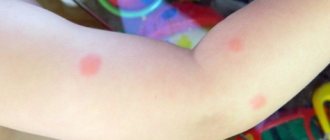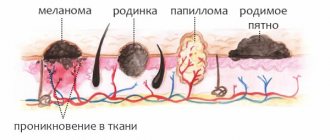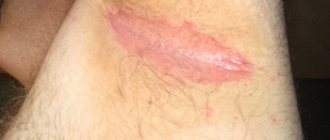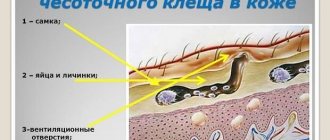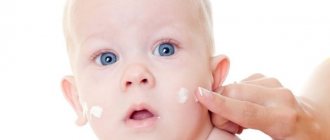What is hyperhidrosis
A person has 2 types of sweat glands, which differ in their functions and regulatory mechanisms:
- Apocrine glands - most of them are located in the armpits and around the external genitalia, regulated by the sympathetic nervous system, adrenergic fibers, where the main substance is adrenaline. They begin to function in adolescence, produce a secretion with pheromones - an individual smell; under stress, the function increases, but they do not participate in thermoregulation.
- Eccrine glands - the largest number - are located in the armpits, on the feet and palms, and secrete the liquid part of sweat. The main regulator of the function is acetylcholine. The glands are involved in thermoregulation and sweating during stress.
The work of the vegetative unequal system, which controls the sweat glands, is not controlled by consciousness. Therefore, it is impossible to cause increased sweating on your own; it increases in response to an increase in body temperature during illness, in hot weather or after physical activity. Sweating increases with excitement, emotional stress, which leads to the release of adrenaline.
But the condition of hyperhidrosis is different from normal sweat production. The glands work actively when a person is calm and does not overheat. This is often associated with various pathologies. There is diffuse hyperhidrosis, in which sweating increases throughout the body. The disease is often associated with pathology of the nervous system. Local, or focal hyperhidrosis, affects only one area of the body. This form is more common than others.
Sweating may be seasonal and occur only in the hot season, but for most people with pathology it does not depend on the season.
Causes of excessive sweating
Patients most often turn to dermatologists with the primary form of pathology, for which it is impossible to establish the cause. The first symptoms of hyperhidrosis appear during puberty. In girls and boys, this is associated with increased activity of the hormones testosterone and cortisol and immaturity of the nervous system. Daily sweat production becomes strong, activity increases in all types of sweat glands. This is why body odor increases in teenagers.
It is believed that primary hyperhidrosis in 30-50% of patients is associated with hereditary factors. But the first symptoms may appear at the age of 20-30 years. They are provoked by chronic stress, hormonal changes and other reasons. The secondary form of excessive sweating of the armpits is associated with the following conditions:
- excitability and high activity of the autonomic nervous system;
- endocrine pathologies, most often the state of hyperthyroidism, insulin resistance in diabetes mellitus;
- diseases of the cardiovascular system, accompanied by cardiac arrhythmias and rapid heartbeat;
- some types of malignant and benign tumors;
- metabolic disorders and excess body weight;
- overdose or side effects of drugs affecting the autonomic nervous system.
It is not always possible to determine the cause of excessive sweating. But it helps to effectively combat sweating.
Treatment
Help before diagnosis
To reduce the unpleasant odor of sweat and prevent irritation, it is necessary to take a hygienic shower at least 2 times a day, use underwear made from natural fabrics and loose clothing that does not rub the skin. In some cases, herbal sedatives are effective, which normalize the functioning of the nervous system and reduce psychological discomfort. If you experience excessive sweating, you should consult a specialist to find out the cause of hyperhidrosis and select the optimal treatment regimen.
Conservative therapy
Medical tactics for sweating are aimed both at relieving the underlying disease and at reducing subjective discomfort. Medicines are combined with physical therapy methods - reflexology, electrophoresis with solutions of anticholinergics. To eliminate psychological problems associated with increased sweat production, individual psychotherapy sessions are offered. To treat hyperhidrosis, medications such as:
- Sedatives
. Sedatives normalize the autonomic regulation of sweating and reduce the functional activity of apocrine sweat glands. For severe hyperhidrosis, tranquilizers are used. - Local agents
. Anticholinergics are often used. Medicines with tanning properties are effective - aluminum salts, plant extracts, which reduce sweat production and reduce skin irritation. - Hormonal drugs
. Used as replacement therapy for various endocrine disorders. In most cases, after correction of hormonal levels, excessive sweating completely disappears. - Antibacterial agents
. Antibiotics help prevent secondary bacterial skin lesions in areas of constant friction. Widely used for etiotropic treatment of infections accompanied by hyperhidrosis. - Botulinum toxin
. The drug is used for local sweating and is administered subcutaneously or intradermally. The product blocks the transmission of nerve impulses to the sweat glands, which helps reduce sweating.
Sweaty armpits in women
In the female body, the release of large amounts of sweat depends on hormonal levels. When it changes, the interaction of various parts of the autonomic nervous system changes. This process is most pronounced during menopause.
With a decrease in ovarian function in women, their stimulation by pituitary hormones - follicle-stimulating and luteinizing hormones - increases. But due to physiological characteristics, the release of thyroid-stimulating hormone, which increases blood flow in the thyroid gland, simultaneously increases. Most often this process starts in the evening or at night. It manifests itself in the form of hot flashes - the appearance of a feeling of heat in the upper body and head. The woman begins to sweat heavily. The duration of such an attack is several minutes.
You are more likely to experience heavy sweating if you are overweight. Thermoregulation disorders appear with arterial hypertension. These diseases also often progress after age 50. Hyperhidrosis in this case is secondary. It is not life-threatening, but causes discomfort.
The smell, where does it come from? How to get rid of it?
Sweat is thought to smell bad, but this is not true because it is 90% water. Unpleasant armpit odor appears due to the accumulation of bacteria instantly formed due to excessive sweating. These bacteria can cause skin irritation or inflammation.
A girl with wet, foul-smelling armpits does not make an aesthetic impression.
Underarm sweating in men
The functioning of the male body is regulated by the hormone testosterone. It performs an anabolic function and accelerates metabolism. Sensitivity to adrenaline is also higher in men. Therefore, small bursts of this hormone speed up the heart rate, increase reaction speed and lead to sweaty armpits.
A man may sweat more than usual if he prefers hot and spicy foods. Sweating of the armpits and the entire body greatly increases when drinking alcoholic beverages. In this case, hyperhidrosis is associated with metabolic processes, as the body removes toxic substances after recycling ethanol. Nicotine has a direct stimulating effect. It increases the synthesis of acetylcholine, which enhances the work of the sweat glands. Therefore, sweating is a natural phenomenon in men who smoke.
Sweating occurs when there is severe nervous tension. Men's jobs are more likely than women's to involve stress or hazardous activities.
Men are susceptible to developing obesity, metabolic disorders and hypertension. Those at risk are those who lead a sedentary lifestyle and have a large waist circumference at the age of 45-50. These disorders affect the tone of the sympathetic nervous system and sweating.
Men, women, children
Human skin contains millions of sweat glands. And this is a necessary condition for normal life. Harmful substances and toxins are eliminated with sweat; with the help of sweat, the body cools and heals. Excessive sweating in men, women and children can have various causes.
Excessive sweating in men
This is partly a genetically determined condition. Men do more physical labor, overheat more often and have a greater need to cool down. In addition, differences in body weight matter. Larger, heavier men sweat more.
Excessive sweating in women
On average, women sweat 2 times less than men. However, hyperhidrosis occurs in them with the same frequency as in men. Excessive sweating in both sexes can be caused by the same reasons. The approaches to treating this condition are also similar.
The only distinct cause of female hyperhidrosis lies in changes in female hormone levels. We can talk about hormone-dependent sweating in the following cases:
- If severe sweating occurs for short periods during each month, then we can safely talk about the hormonal cause of hyperhidrosis.
- If severe sweating occurs during pregnancy and lactation, then this is also the result of fluctuations in the level of female sex hormones.
- If excessive sweating occurs during menopause.
What to do in such cases? Contact your gynecologist. After determining hormone levels, the doctor may decide to prescribe hormone replacement therapy.
What to do if excessive sweating bothers your child
If excessive sweating is diagnosed in children over 6 years of age, then this condition can be caused by the same reasons as in an adult.
Newborn babies do not sweat at all, but starting from the age of two months, children can sweat heavily in the following cases:
- during feeding, especially if the mother is breastfeeding;
- if the child is dressed too warmly;
- if he screamed and cried for a long time.
Children under 3 years of age often sweat profusely while sleeping. Many pediatricians consider this completely natural. You should not try to get rid of this condition. Most likely, over time, the child will “outgrow” such sweating.
Many people mistakenly associate severe sweating with rickets - you shouldn’t make hasty conclusions! Moreover, rickets has many other, more obvious manifestations.
When to see a doctor
If a person begins to sweat during exercise, hot weather, or extreme excitement, there is no reason to worry. Health problems are indicated by sweating, which occurs against a background of complete calm or is accompanied by additional symptoms.
A slightly elevated body temperature, which is accompanied by night or evening sweats, may be a sign of a chronic infection. Sometimes this is how pulmonary tuberculosis, immune disorders, and the initial stages of cancer manifest themselves.
A dangerous symptom is the appearance of weakness, dizziness, loss of consciousness against the background of increased sweating. This may be a sign of low glucose levels - hypoglycemia. The condition is life-threatening and therefore requires emergency medical attention. Hyperhidrosis is cured only after glucose levels are normalized.
Older women who experience menstrual irregularities and the first symptoms of approaching menopause require special treatment. Without special means, the condition may gradually worsen, and menopause will be difficult.
Increased sweating is one of the signs of thyrotoxicosis. This disease is accompanied by an increase in thyroid function and the release of increased doses of hormones into the blood. At the same time, the heartbeat increases, heart rhythm disturbances appear, and the person quickly loses body weight, despite maintaining the nature of the diet.
Prevention
To avoid unpleasant sensations arising from excessive sweating, it is enough to follow some rules:
- the detected problem should be immediately shared with your doctor;
- take a shower daily;
- do not consume food or alcoholic beverages immediately before bedtime;
- Constantly control your weight;
- try to wear clothes made from natural fabrics and eliminate synthetic materials from everyday use as much as possible;
- use deodorant or antiperspirant.
To improve your well-being, it is recommended to take baths with the addition of soothing ingredients - sage, oak bark, fir.
>

